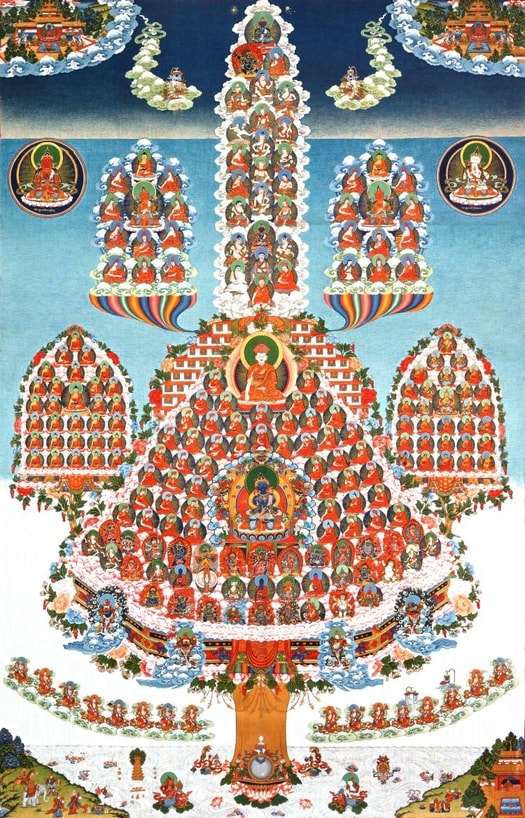|
Gongchig
The ''Gongchig'' (, "Single Intention" or "One Thought") is a book of commentary on the Buddha's teaching by Jigten Sumgon (1143–1217), the founder of the Drikung Kagyu lineage who is believed to be the reincarnation of Nagarjuna. He taught the Dharma to several thousand students for forty years. Composition The ''Gongchig'' was written out by his heart disciple Won Sherab Jungne (1187–1241). It is a late summary of the Buddha's teachings, in which Jigten Sumgon laid out the path of the Buddha's teachings as well as actual practice. The ''Gongchig'' is composed of 152 primary vajra statements with 46 supplemental vajra statements. Won Sherab Jungne arranged these vajra statements into eight chapters of varying length: #Summary of the Key Points of the Wheel of Dharma (30 Statements) #Summary of the essential points of the emergence in dependence (15 statements) #Summary of the Essential Points of the Vinaya Pratimoksha (20 Statements) #Summary of the Essential Points of the ... [...More Info...] [...Related Items...] OR: [Wikipedia] [Google] [Baidu] |
Drikung Kagyu
Drikung Kagyü or Drigung Kagyü ( Wylie: 'bri-gung bka'-brgyud) is one of the eight "minor" lineages of the Kagyu school of Tibetan Buddhism. "Major" here refers to those Kagyü lineages founded by the immediate disciples of Gampopa (1079-1153), while "minor" refers to all the lineages founded by disciples of Gampopa's main disciple, Phagmo Drupa (1110-1170). One of these disciples, Jigten Sumgön (1143-1217), is the founder of Drikung. History Like with all other Kagyu lineages, origins of Drikung Kagyü can be traced back to the Great Indian Master Tilopa who passed on his teachings to Mahasiddha Naropa who lived around 10th and 11th century. The founder of the Drikung Kagyü lineage was Jigten Sumgön (1143-1217) of the Kyura clan, who was the disciple of Phagmo Drupa. According to historical account from the time, Jigten Sumgön's teachings attracted more than 100,000 people at a time, with the highest number of attendance recorded at 130,000. Several sub-schools ... [...More Info...] [...Related Items...] OR: [Wikipedia] [Google] [Baidu] |
Nagarjuna
Nāgārjuna (Sanskrit: नागार्जुन, ''Nāgārjuna''; ) was an Indian monk and Mahayana, Mahāyāna Buddhist Philosophy, philosopher of the Madhyamaka (Centrism, Middle Way) school. He is widely considered one of the most important Buddhist philosophers.Garfield, Jay L. (1995), ''The Fundamental Wisdom of the Middle Way'', Oxford: Oxford University Press. Nāgārjuna is widely considered to be the founder of the Madhyamaka school of Buddhist philosophy and a defender of the Mahāyāna movement. His ''Mūlamadhyamakakārikā'' (''Root Verses on Madhyamaka'', MMK) is the most important text on the Madhyamaka philosophy of Śūnyatā, emptiness. The MMK inspired a large number of commentaries in Sanskrit, Chinese, Tibetan, Korean and Japanese and continues to be studied today. History Background India in the first and second centuries CE was politically divided into various states, including the Kushan Empire and the Satavahana dynasty, Satavahana Kingdom. At ... [...More Info...] [...Related Items...] OR: [Wikipedia] [Google] [Baidu] |
YouTube
YouTube is an American social media and online video sharing platform owned by Google. YouTube was founded on February 14, 2005, by Steve Chen, Chad Hurley, and Jawed Karim who were three former employees of PayPal. Headquartered in San Bruno, California, it is the second-most-visited website in the world, after Google Search. In January 2024, YouTube had more than 2.7billion monthly active users, who collectively watched more than one billion hours of videos every day. , videos were being uploaded to the platform at a rate of more than 500 hours of content per minute, and , there were approximately 14.8billion videos in total. On November 13, 2006, YouTube was purchased by Google for $1.65 billion (equivalent to $ billion in ). Google expanded YouTube's business model of generating revenue from advertisements alone, to offering paid content such as movies and exclusive content produced by and for YouTube. It also offers YouTube Premium, a paid subs ... [...More Info...] [...Related Items...] OR: [Wikipedia] [Google] [Baidu] |
Tibetan Buddhist Philosophical Concepts
Tibetan may mean: * of, from, or related to Tibet * Tibetan people, an ethnic group * Tibetan language: ** Classical Tibetan, the classical language used also as a contemporary written standard ** Standard Tibetan, the most widely used spoken dialect ** Tibetan pinyin, a method of writing Standard Tibetan in Latin script ** Tibetan script ** any other of the Tibetic languages Tibetan may additionally refer to: Culture * Old Tibetan, an era of Tibetan history * Tibetan art * Music of Tibet * Tibetan rug * Tibetan culture * Tibetan cuisine Religion * Tibetan Buddhism * Tibetan Muslims Other uses * Tibetan alphabet * Tibetan (Unicode block) * Tibetan name * Tibetan calendar * Tibetan Spaniel, a breed of dog * Tibetan Mastiff, a breed of dog See also * Tibet (other) * Tibetan Bells (other) * Traditional Tibetan medicine * Tibetan language (other) Tibetan language may refer to: * Lhasa Tibetan or Standard Tibetan, the most widely used spoken dialect * ... [...More Info...] [...Related Items...] OR: [Wikipedia] [Google] [Baidu] |

